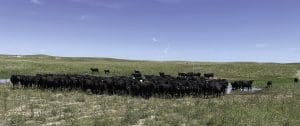By David MacKenzie Contributing Editor

Editor’s Note: David MacKenzie, beef and sheep director at HARBRO Limited, leads a team charged with changing and improving the nutritional and financial performance of beef and sheep operations in the United Kingdom. He recently toured U.S. cow-calf operations and feedyards. Part 1 covers his observations of the differences between U.S. and U.K. cow-calf production.
I was in the fortunate position of recently visiting the United States, looking at both beef feedyards and cow-calf operations across Texas, Kansas, Nebraska and Colorado. The purpose of the trip was to look at the most progressive nutritional and management advances that are being put into practice in the United States. My goal was to understand the latest academic findings, how they fit into the cowboy’s day-to-day challenges, and how this compares to the United Kingdom’s beef industry. Most important, I was interested in their relevance and transferable learnings.
In the United Kingdom, suckler (cow-calf) production is very regional and mainly concentrated in the west side of the country, which can receive an annual rainfall of 60 to 100 inches. What struck me early on in my U.S. visit was the importance of rainfall and the ongoing drought’s impact on cow-calf producers, particularly rancher Dan Kelly of the Kelly Ranch in Sutherland, Neb. Kelly, a fourth-generation rancher, explained his situation.
“We just didn’t get the rainfall last year, which meant we couldn’t carry the stock numbers throughout the fall and winter,” he said. “We culled all cows over 9 years old and sold our replacement heifers to manage the situation.
“This year, we are in a far better position, and livestock are undoubtedly carrying more weight.”
Kelly is running 1,200 head of mainly Angus and Sim-Angus and, like many producers, runs bulls with cows for 50 days. When comparing this to the United Kingdom, we would be typically running bulls for 63 to 84 days. All of Kelly’s heifers are synchronized and AI’d to Angus bulls to calve at 2 years of age. There is much debate in the United Kingdom about at what age heifers should calve. The number of producers successfully calving at 2 years of age is low; generally, the average is 35 months at first calving. Kelly has been working closely with the University of Nebraska-Lincoln, looking at heifer weights at conception and what the nutritional impacts are having on reaching full mature cow weights.
Obviously, trying to winter that cow as efficiently as possible is paramount to cow-calf ranchers everywhere. I guess that every rancher believes that they have their own cow and breed type that best fits their location, demographics and ultimately the market for that calf.
In the United Kingdom, we have some people who can winter cows outside on more sandy-type soils, but the majority are housed for five to seven months on straw-bedded courts or slatted buildings where cows are located in non-arable growing areas.
I also visited Leachman Cattle of Colorado (LCC). They have successfully exported the Stabilizer composite to the United Kingdom. As one of the biggest producers of seedstock bulls, selling Angus, Red Angus, Stabilizer and Charolais, I had a particular interest in the different type of Charolais they breed, as the horned genetics are dominant within our gene pool for the breed. Our frame size would be a bit taller and would have a little bit more daylight underneath but wouldn’t be as easy fleshed.
Whether it was in the feedyards or cow-calf units, nutritional and animal health products coming onto the U.S. market requires a high level of product integrity before entering the market. I discovered that any product had to have academic and scientific research published first, then needed to be put through the very impressive and vigorous R&D systems managed on the yards to enable creditability and large-scale practice that would give a major yard confidence to introduce the product. No simple product comparison with a heavy dose of marketing can get off the ground, which I found very impressive and refreshing. Obviously, this commands a far greater budget to bring a product to market than in the United Kingdom or Europe, but with the greater livestock numbers in the United States, the payback makes sense.







